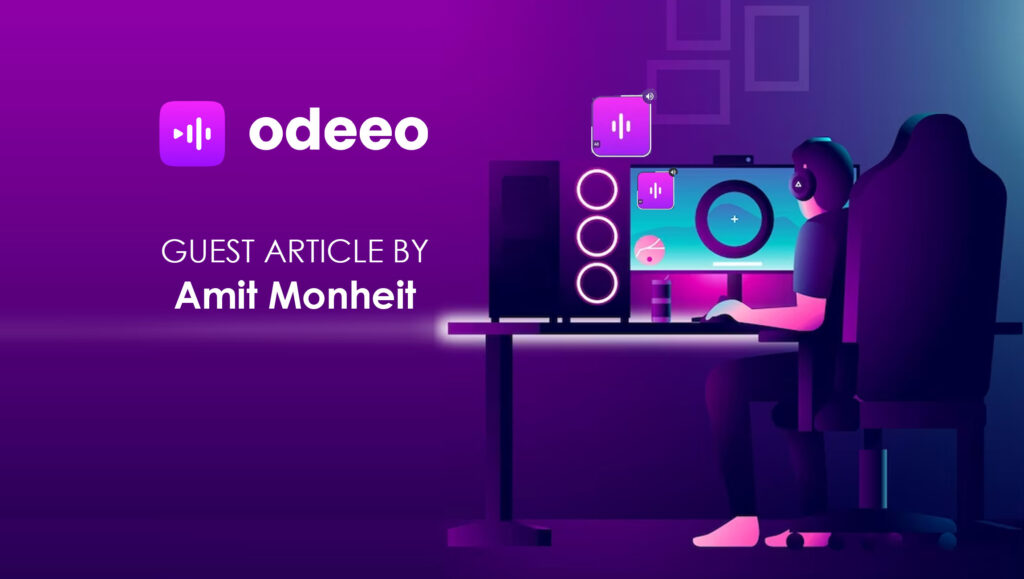Amit Monheit, CEO and co-founder at Odeeo, discusses how the attributes of an in-game audio ad drive performance for advertisers.
For years, digital audio advertising had been underdeveloped and underinvested. Thanks to pandemic-driven behavior changes and technological innovation, that’s no longer the case; audio investment has been the fastest-growing among ad formats in the past five years, according to the IAB. And as we saw the boom in podcast and streaming audio advertising, my co-founder Elad and I started Odeeo to bring digital audio ads into the massive world of mobile games.
Mobile games have been around since the time of snake on Nokia phones, but the ad-supported gaming ecosystem that evolved with the advent of the app stores has become a $60B+ industry. Over 90% of games in app stores are ad supported, and there are over 2.7B mobile gamers globally. There’s a natural synergy for ads in these environments, and we created an opportunity to monetize playtime rather than interruption with audio.
But from the beginning, stakeholders across the ecosystem had a question: would it work?
What defines digital audio ads success?
Like all advertising, successful digital audio advertising must drive some change in behavior. Audio has traditionally been a branding channel, so success is demonstrated as a measurable change in brand awareness or affinity, followed by hopefully moving a listener further down the purchase journey. Recent research from Dentsu demonstrated the superior impact of audio over other formats on ad recall.
Audio has also been a successful direct response channel, historically telling listeners to “call now” to claim an offer. The shift to digital has only amplified audio’s power to drive action among listeners. Many direct response advertisers, including direct to consumer brands and insurance providers, leverage digital audio as part of their performance advertising mix.
Unique to digital environments, every impression is quantifiable. So digital metrics like listen-through rate (LTR), completion rate, and even volume levels can all be reported back to advertisers to understand how creative and placement choices can impact ad performance and ultimately campaign outcomes.
Marketing Technology News: MarTech Interview with Rob Fox, CTO, HG Insights
How do in-game audio units perform?
Understanding the user experience with in-game audio ads can help shed light on how to optimize them for advertiser success. Digging into our own traffic, Odeeo analyzed over 75 million impressions from a six week period to understand how players interacted with our ad units.

One of the biggest drivers of success has been that players actually click on the audio ads. While the average click-through on banner ads is .1%, and a “good” click-through for a digital audio ad is .2-.25%, we see click through rates ranging from 1.5-3% coming from in-game.
Naturally, an ad must be heard in order to drive action. Mapping click through rates to understand the impact of volume level on performance, we found that higher volumes do correlate with higher click through rates – up to a point. Engagement increases steadily along with volume from the 11% level, up to around 60%, where it then flattens out.


Along with higher volumes, however, come higher skip rates and slightly lower completion rates. Odeeo’s in-game audio ads are skippable after the first ten seconds, and while 90% of those who listen on average go on to complete the ad, there is some variance based on the device volume.

The biggest impact on completion rate is the length of the ad. As with most ad formats, longer ads do not perform as well as shorter ads. We see a natural fall-off once ads exceed 25 seconds, with continued decline after the 35 second mark.
Marketing Technology News: The Impending Cookieless Future Has Everyone In Advertising Fearful About What’s Next
What does this mean for advertisers?
The high completion rates and click rates yield strong brand lift and performance results for advertisers, as we’ve seen with campaigns for telco and fitness clients.
When incorporating in-game audio into their plan, advertisers must be mindful of their creative choices and leverage shorter ads whenever possible, instead of repurposing longer creative they may be employing in podcasts. They should consider that unlike podcasts and streaming audio, gaming is the only “lean forward” environment for audio advertising, and they need to capitalize on immediate attention – rather than trying to prevent listeners from tuning out.
Overall, advertisers should take a broad view of the audio landscape when planning campaigns, and consider how the performance from in-game audio can bolster their outcomes across their media buys. By reaching a highly engaged, incremental audience that supplements their other audio channels, mobile games can supercharge results in a cost-effective way for all kinds of marketers.






















